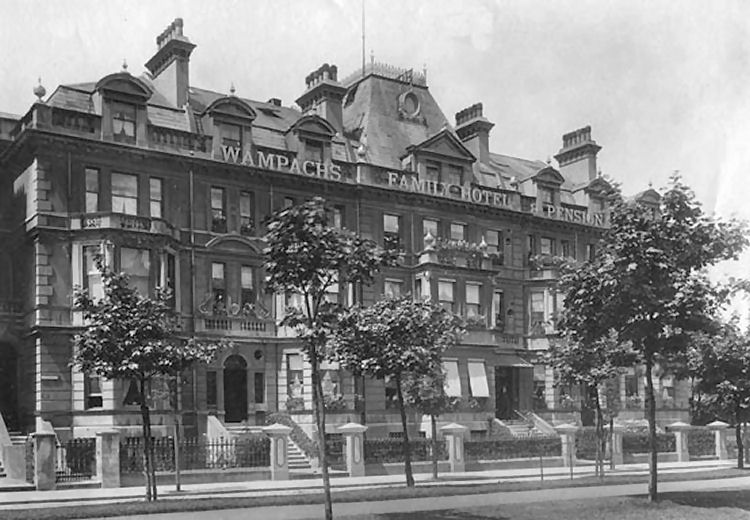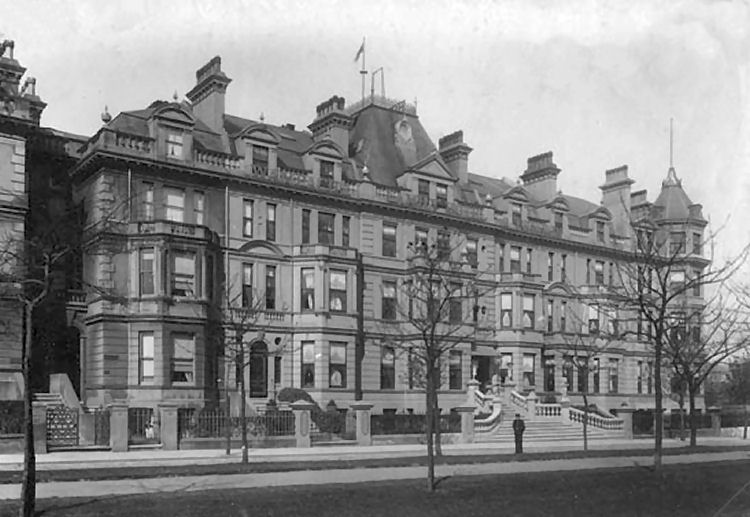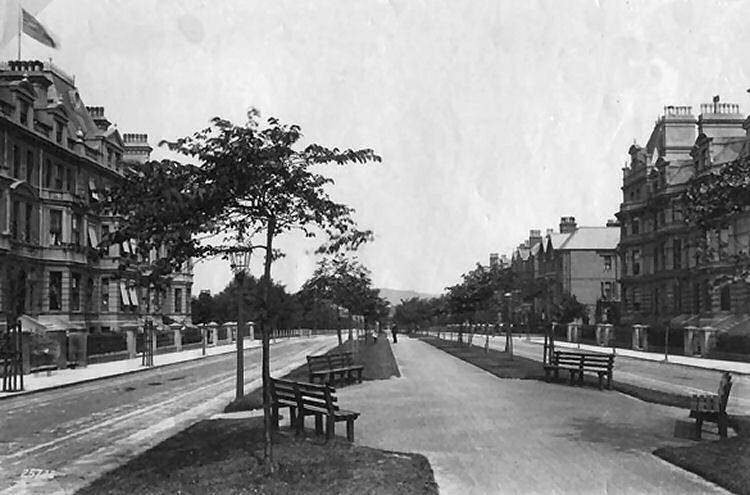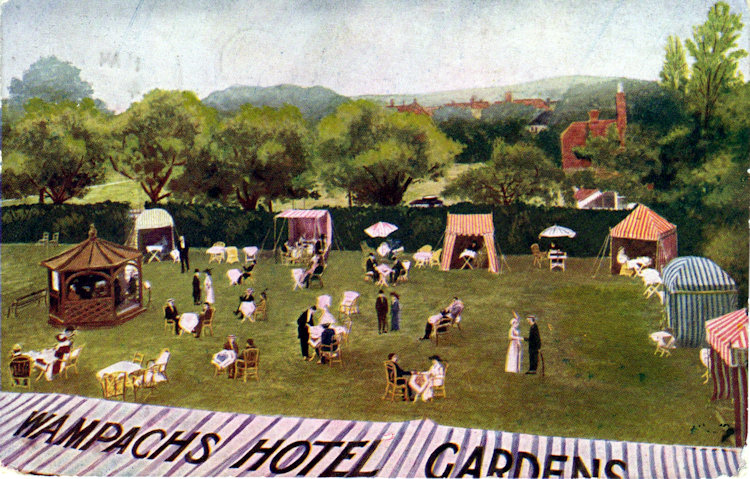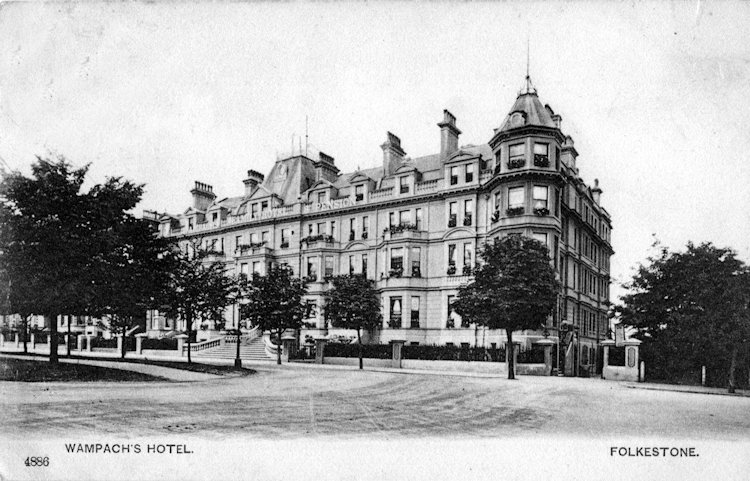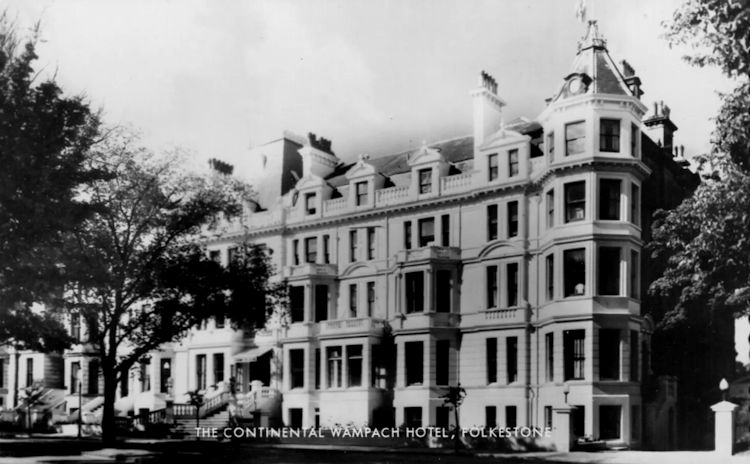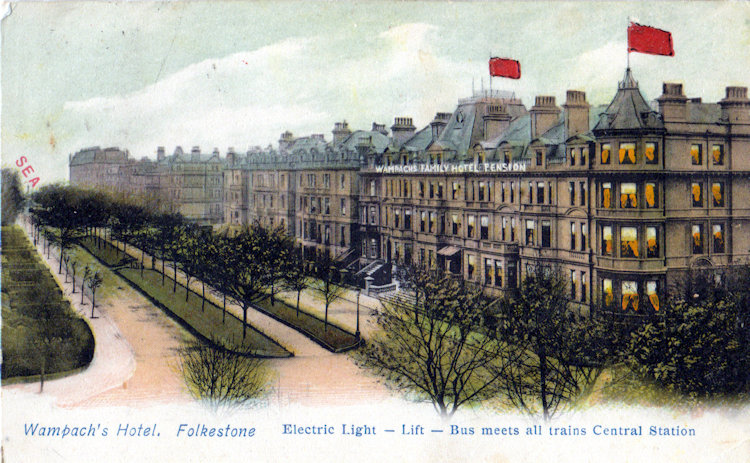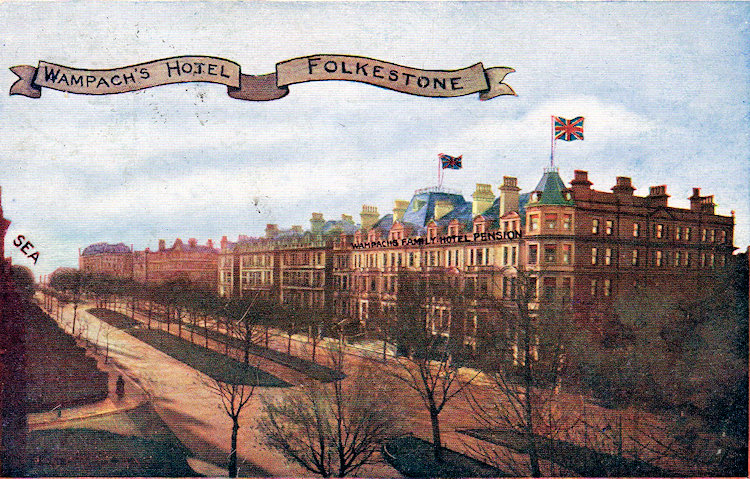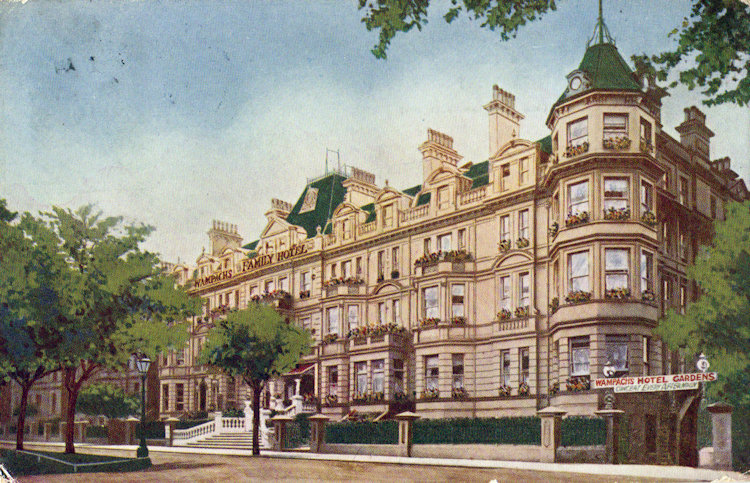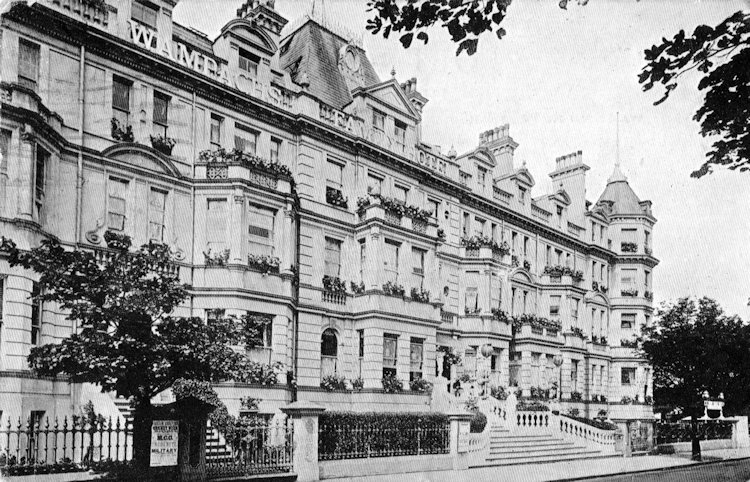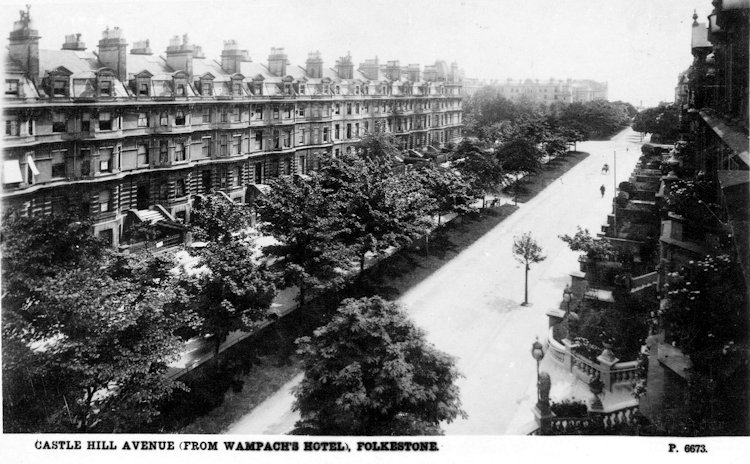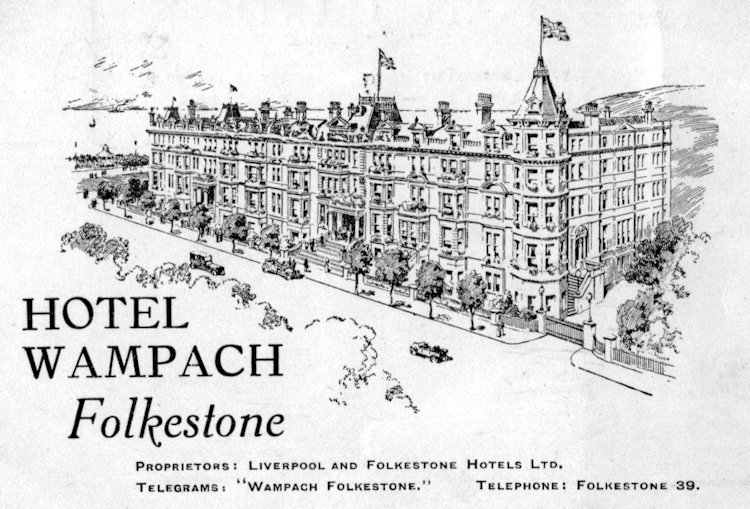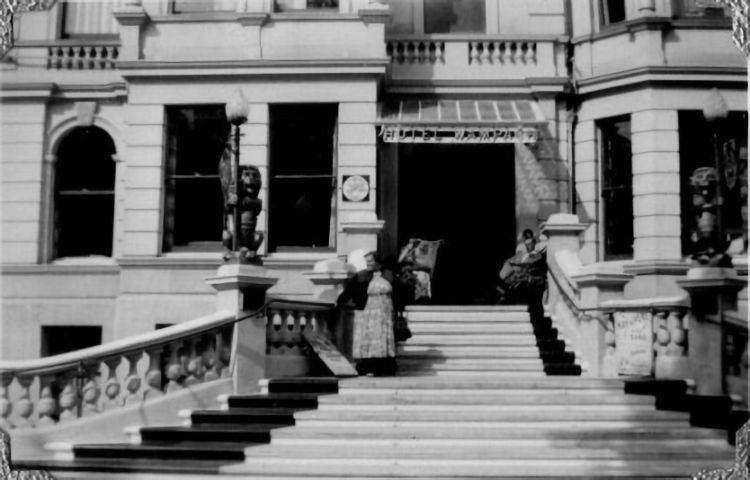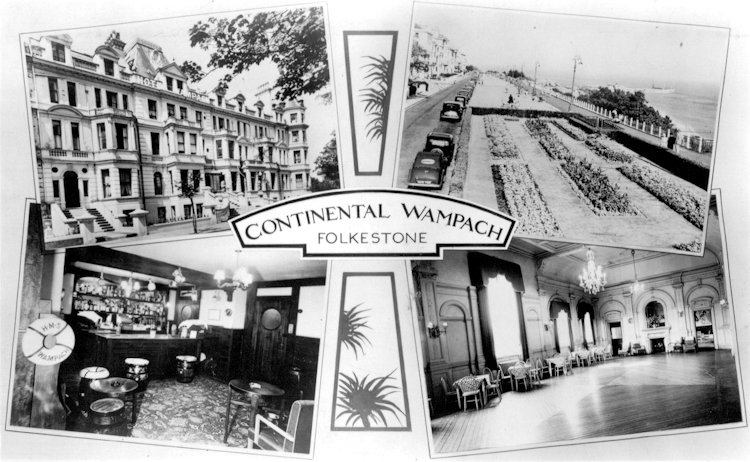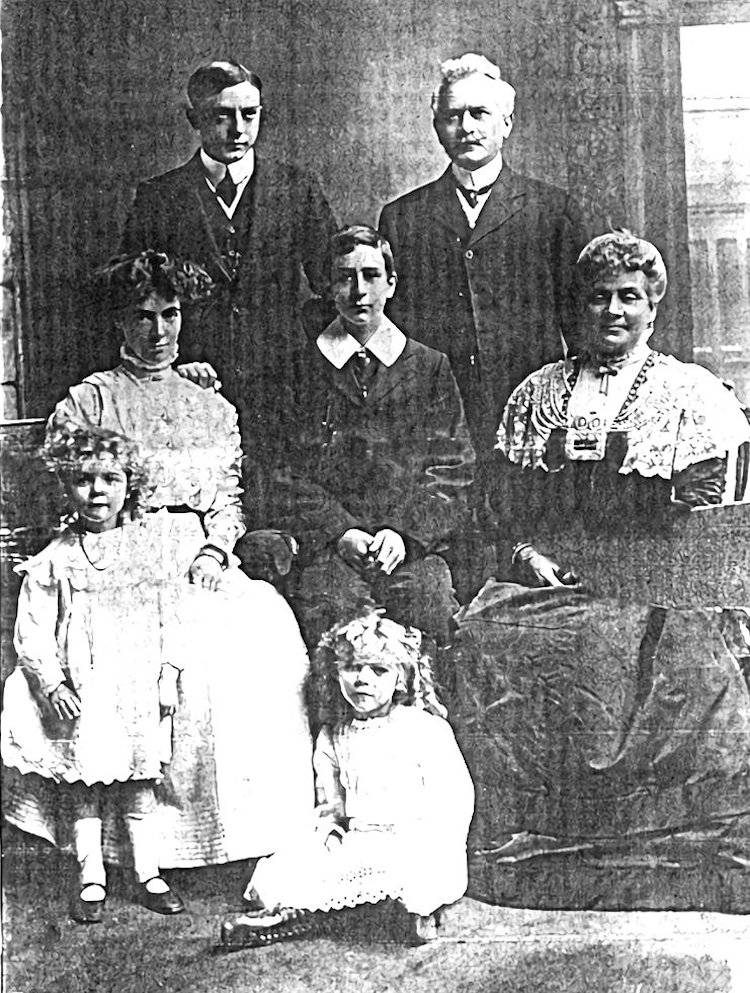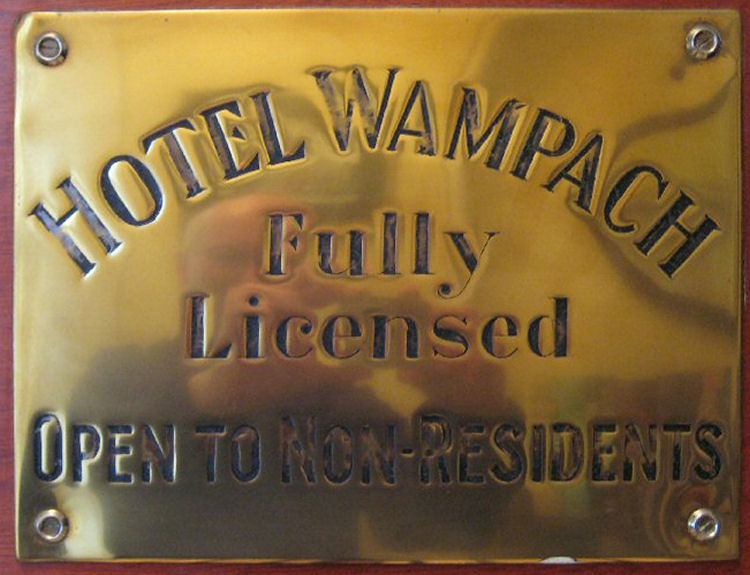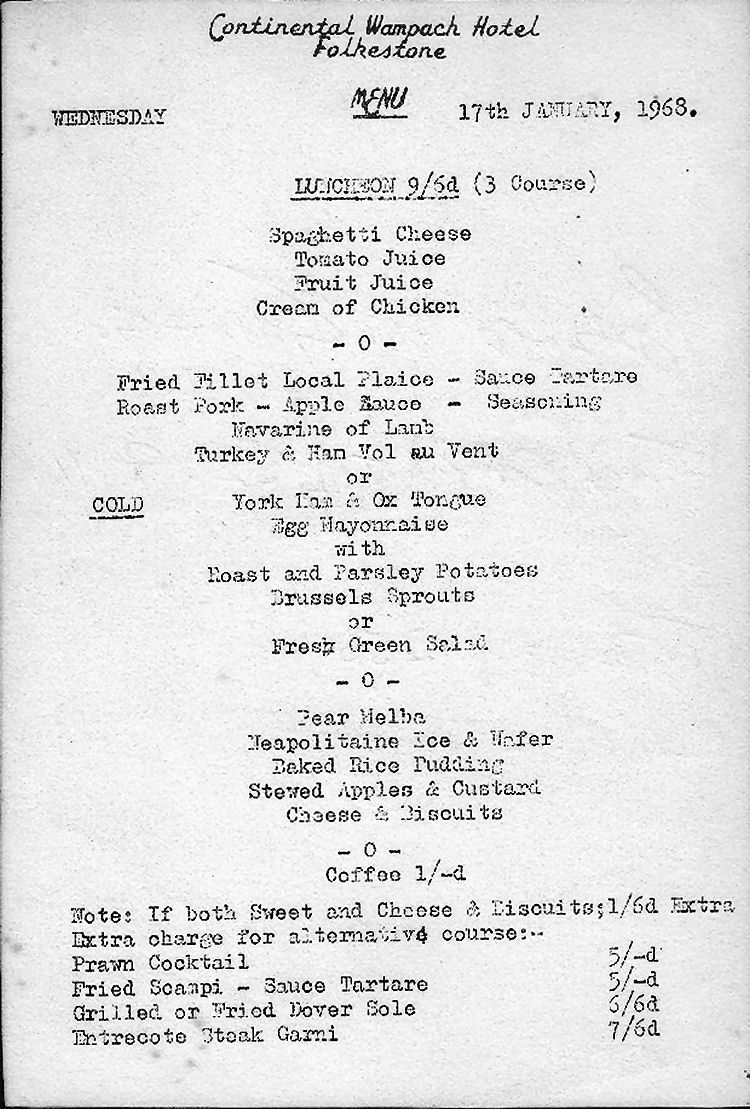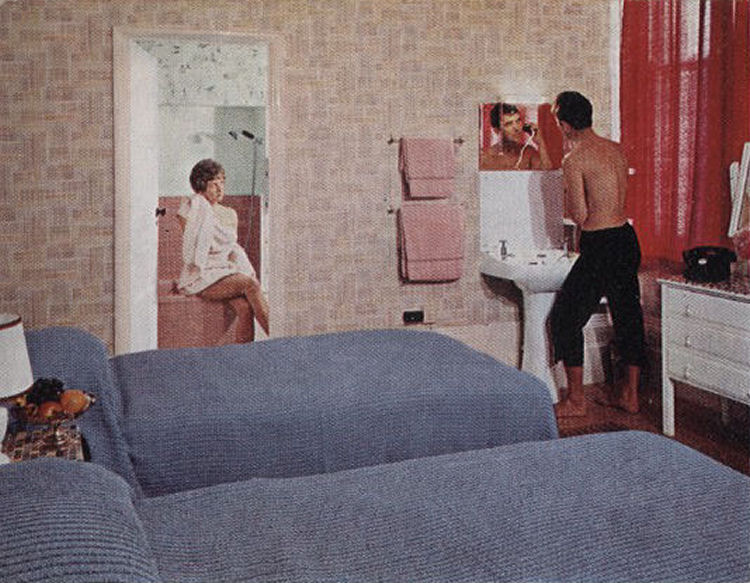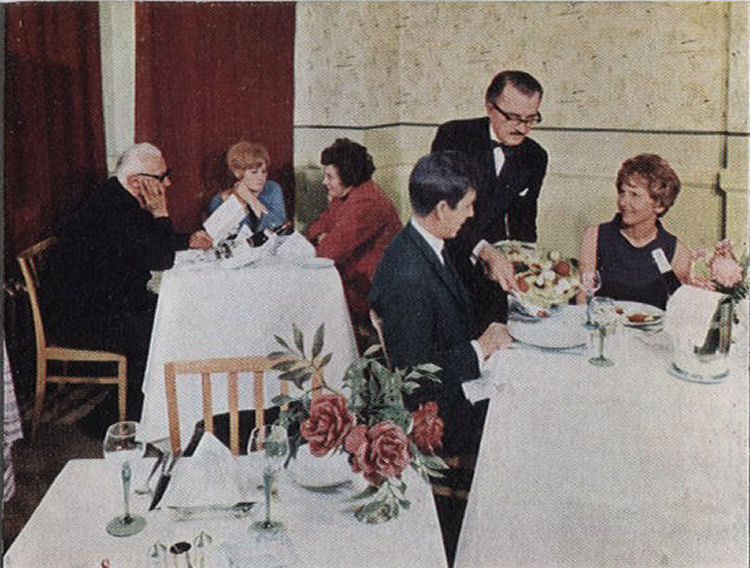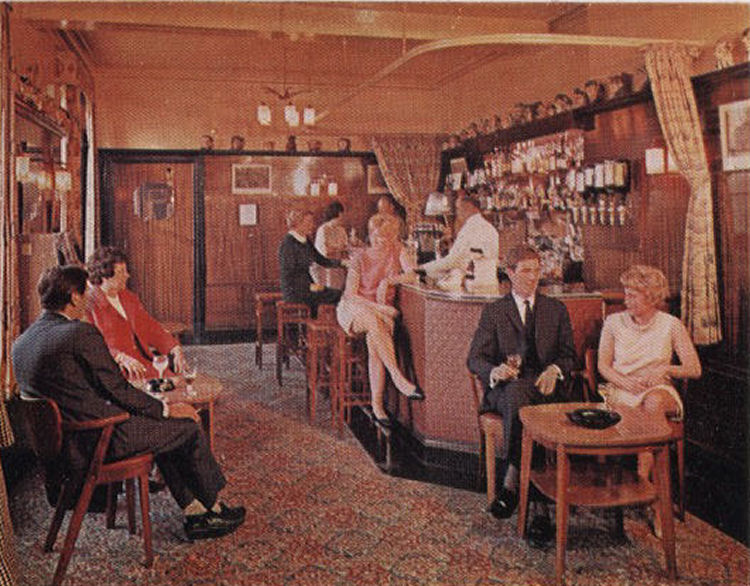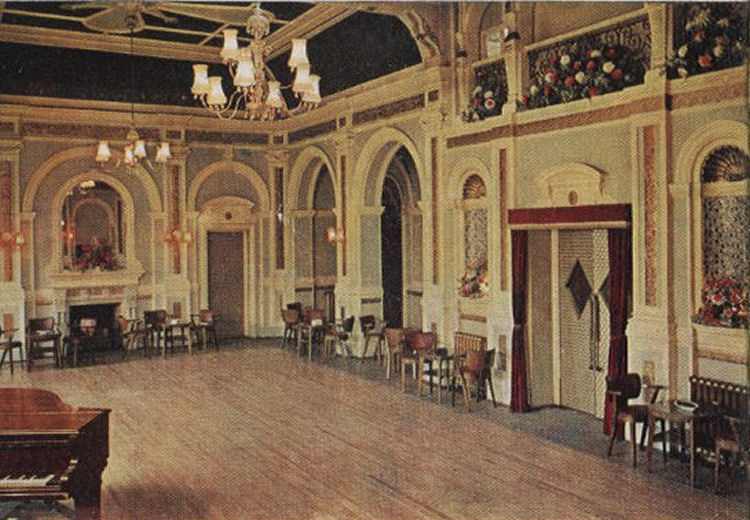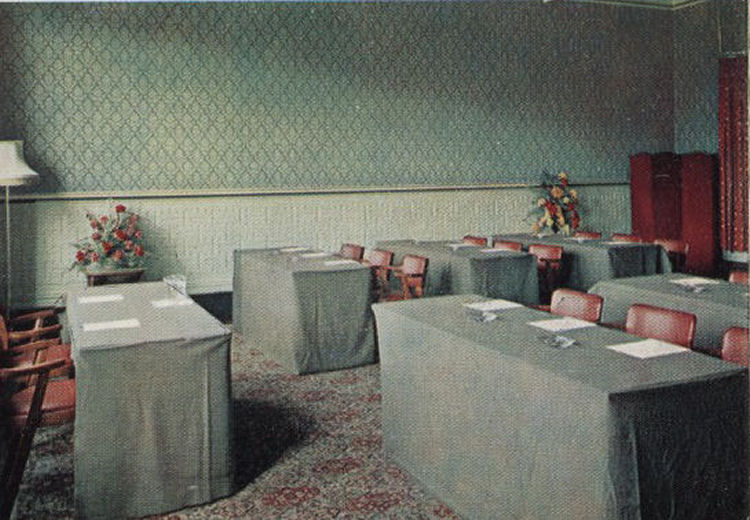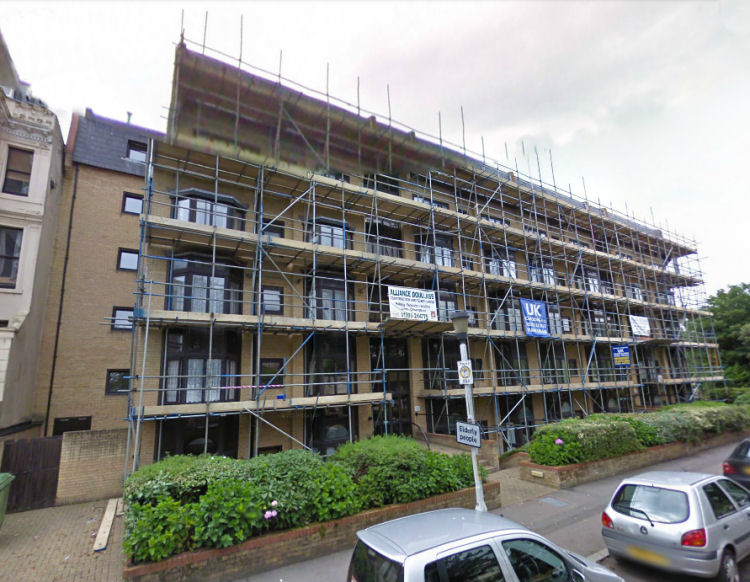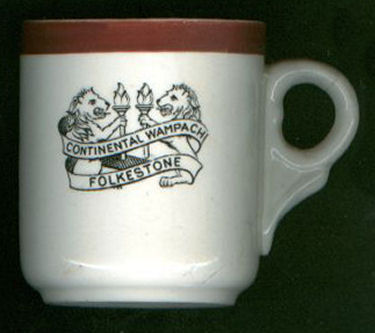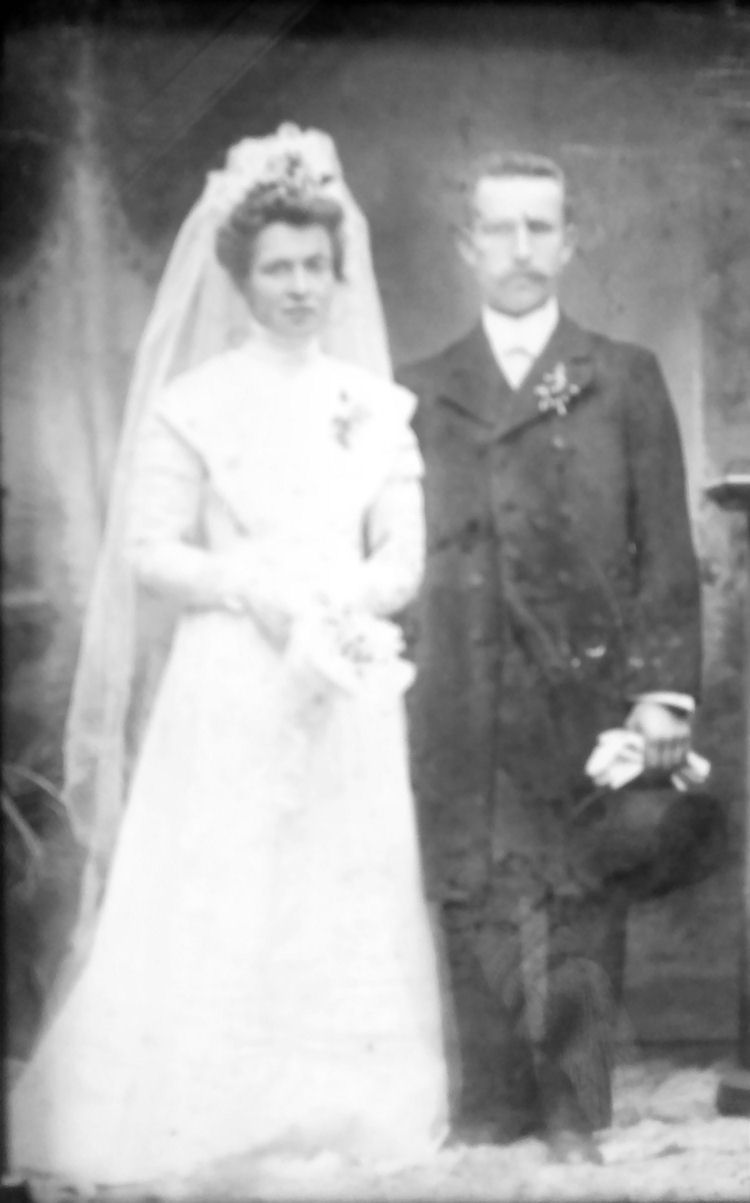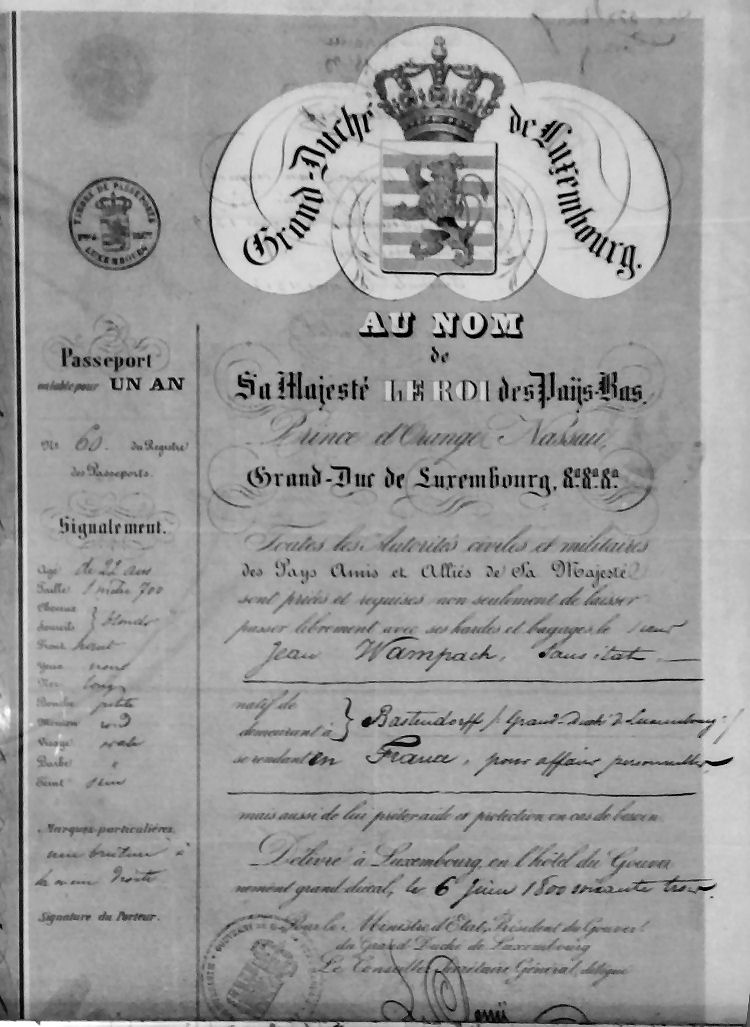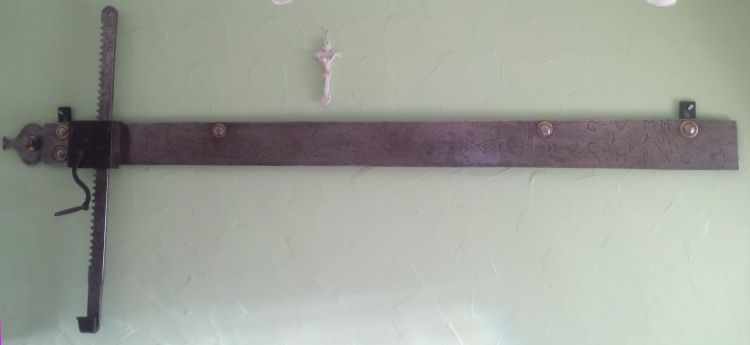|
THE HISTORY OF THE WAMPACH HOTEL, FOLKESTONE
Compiled by J. M. Paine & K. S. Paine
For the
FOLKESTONE & DISTRICT LOCAL HISTORY SOCIETY
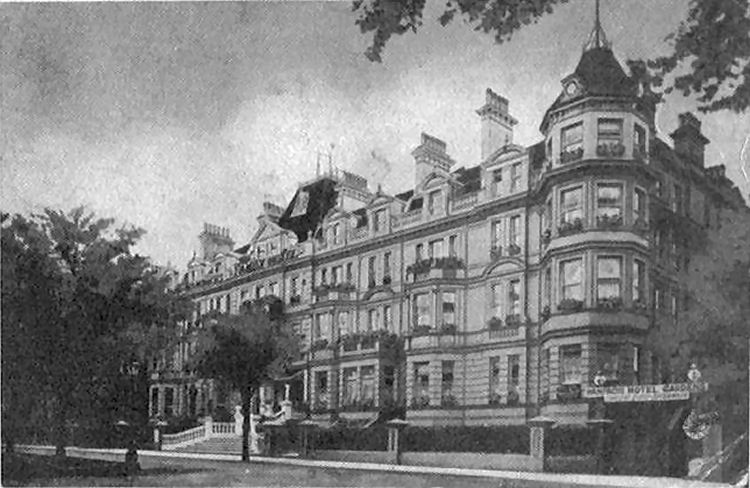
MR CHARLES CONSTANT WAMPACH came to England in 1875. He originated in
Diekirch, Luxemburg, and his fiancée, Julie, came from Westphalia. They
married in 1879.
Mr Wampach was naturalised in 1892. He served as a chef in several
Hotels in Folkestone, including six years at the "Leas Hotel."
In March 1885 he leased a lodging house at 66 Cheriton Road for twelve
months before taking a lease on number 33 Castle Hill Avenue. He
named it The Pension Wampach, and a short time later added number 35.
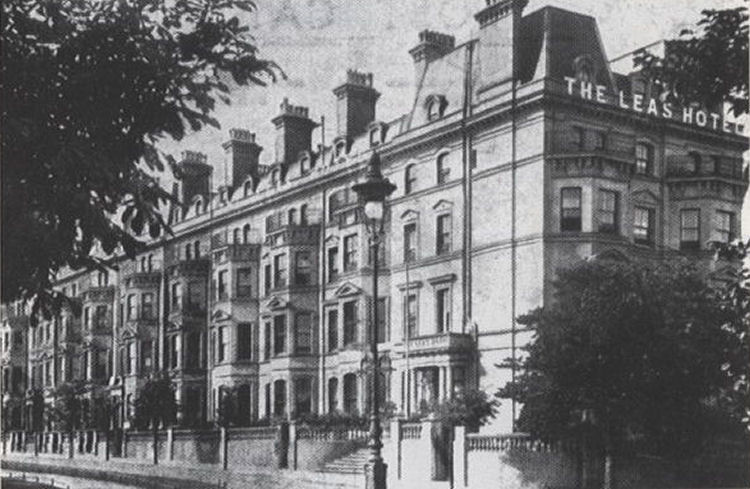
THE LEAS HOTEL NOW LEASIDE COURT.
IN CLIFTON GARDENS.
WHERE CHARLES WAMPACH DID SIX YEARS TRAINING.
In 1896 advertisements in local papers proclaimed:
THE WAMPACH FAMILY HOTEL
Electric light throughout
Bathrooms on all upper
floors
and
Sanitation which has been carefully looked into
Wampach Hotels Limited was formed in 1900, and took leases on numbers 37
and 39 by 1909.
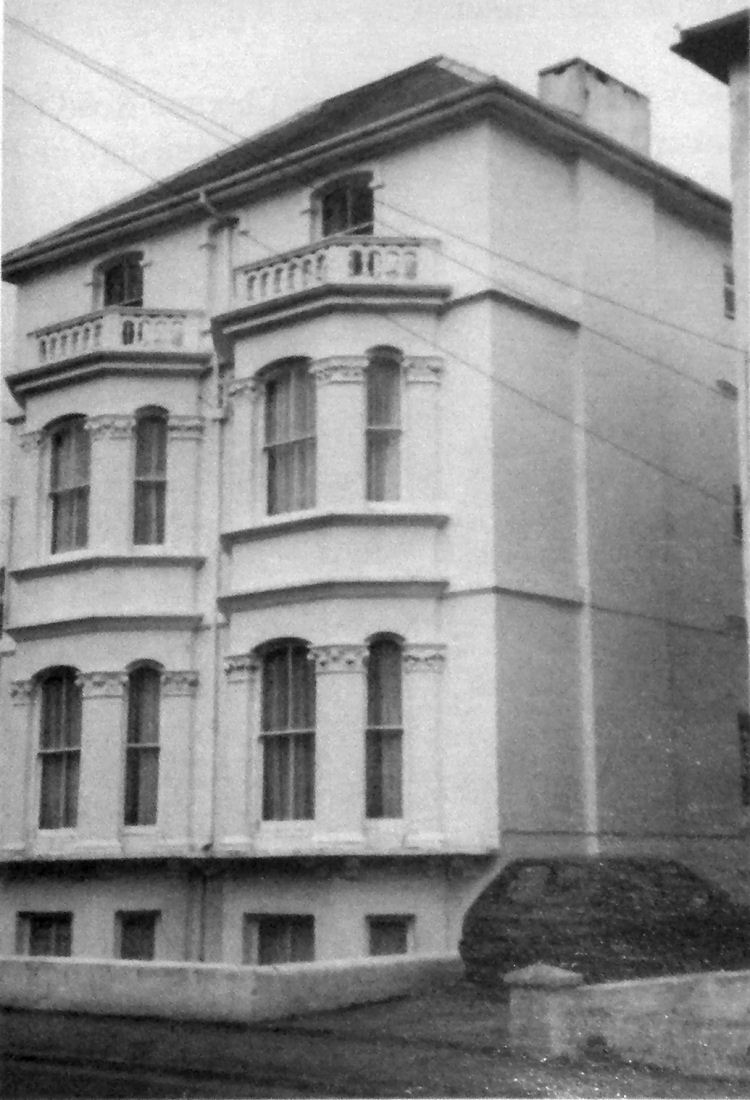
NUMBER 66 CHERITON ROAD, THE FIRST LODGING HOUSE LEASED BY MR.
WAMPACH IN MARCH 1885.

AN EARLY PHOTOGRAPH OF THE WAMPACH FAMILY HOTEL
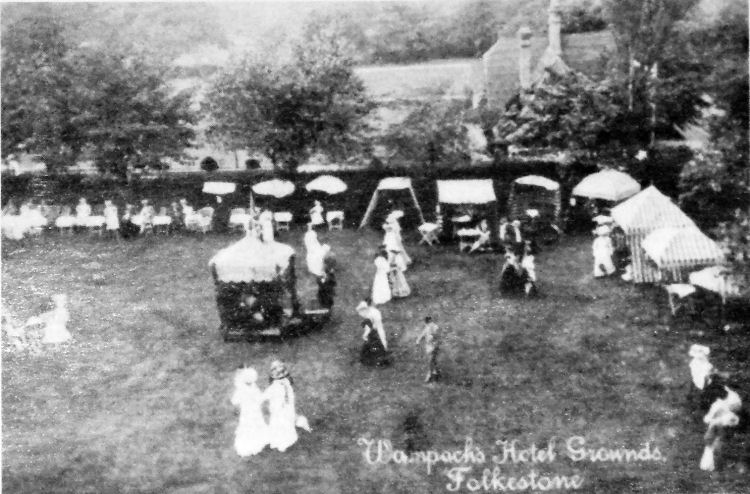
GARDENS AT THE REAR

THE WAMPACH FROM THE GARDENS
The Hotel was commandeered by the Army from 1914 to 1918, re-opening as
The Excelsior in 1920.
Mr and Mrs Wampach suffered considerable bother with 'Spy Mania' during
the first World War, even though their youngest son, Cyril Constant
Julian, was killed in battle in Mesopotania in 1918. His tombstone,
marked with the insignia of The Royal Artillery, is in Newington
churchyard. In spite of the problems however, Charles Wampach
represented the West Ward on the Council from 1902-1918.
An extract from:- Views and Reviews, Folkestone c1898.
The Hotel Wampach,
Castle Hill Avenue, West Cliff,]
Proprietor: Mr. C. C. Wampach.
Telegrams - - "Wampach, Folkestone."
One of the most luxurious hotels in Folkestone is the Hotel Wampach,
which for twelve years past has been conducted under the proprietorship
of Mr. Charles Constant Wampach, after whom it takes its name. Owing to
the steady increase of visitors the premises have had to be enlarged no
fewer than four times since 1886, a fact which says all that need be
said for the efficiency and up to dateness of the management. The
establishment possesses the advantage of a central and favourable
situation, being located on the West Cliff, the healthiest and most
fashionable part of the town, and directly overlooking the pleasure
gardens. It is close to the sea, the Leas and the principal churches,
and within a few minutes' drive of the harbour and the west end
stations. The frontage is of commanding proportions and suggestive of
that elegance which is nowadays expected in every first class
caravanserai. The interior contains upwards of eighty spacious
apartments, including six suites of private rooms, together with state
rooms, a large dining-hall, capable of accommodating 150 guests,
beautifully appointed coffee and table d'hote rooms, ladies'
drawing-room and reading-rooms, lounges, and, in fact, all modem
conveniences. The furnishings, decorations, and general equipment are of
very superior character, the sanitation has been carefully looked to,
bath-rooms, etc., being available on each of the upper floors, and the
electric light is laid on throughout. The house is famous for the
excellence of its cuisine and for the choice and variety afforded by its
daily menu. A superior table d'hote dinner is served every evening in
the large hall from half-past six to eight o'clock, and may be partaken
of by families not residing in the hotel, weekly ticket books being
issued for the purpose. Breakfast from nine o'clock to ten, luncheon
from one o'clock to two, and afternoon tea from five o'clock to
half-past, are likewise provided at table d'hote charges, whilst meals
can be served a la carte at any hour and for parties of any number. A
remarkably reasonable tariff is in vogue, a notable feature of which
is that there is no charge, for attendance, and visitors may either take
rooms and have their meals at tariff rates, or be received on pension,
at an inclusive charge per day. Specially reduced terms have been
arranged for the winter and spring months, i.e., from November 1st to
June 30th, Easter week excepted. Close to the hotel there is a good
range of stabling, loose boxes, etc. A private bus meets all trains at Shorncliffe and Folkestone Central, and flys and open or closed carriages
can be supplied at a moment's notice. The Hotel Wampach is extensively
patronised by the nobility and gentry, and continues to extend its
popularity season by season.
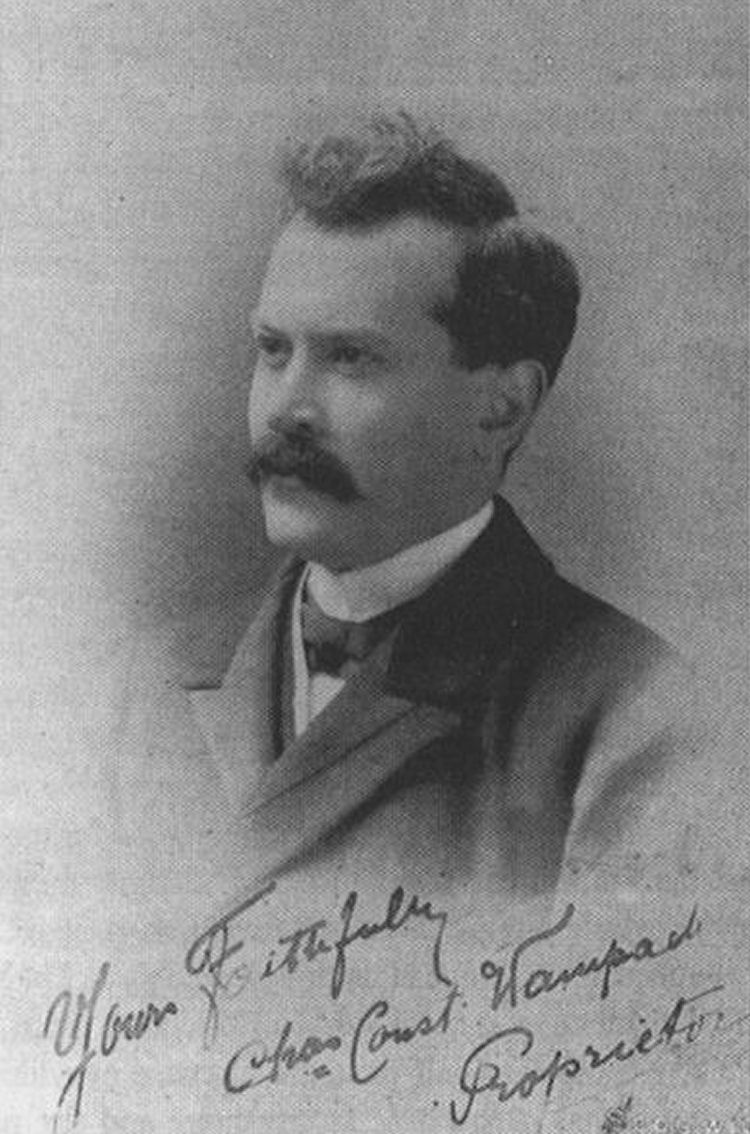
CHARLES CONSTANT WAMPACH
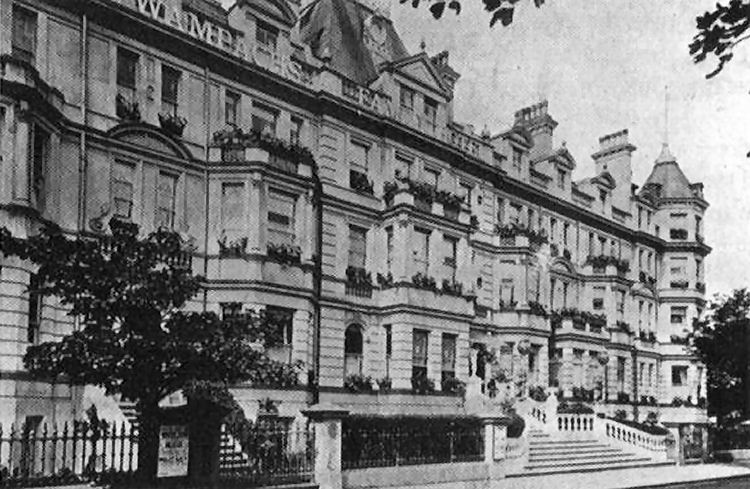
THE WAMPACH FAMILY HOTEL
Following the war, Mr Wampach opened number one Clifton Gardens as a
high class restaurant, also named The Excelsior. However, this was short
lived, and the building was unoccupied during 1919 and 1920. It became
Excelsior Mansions from 1921 to 1922, advertising Private Apartments.
The Wampach Hotel (as The Excelsior) was offered for sale by auction on
31st January 1921. At that time there were 61 years remaining on the
lease and the Ground Rent was £120 per annum.
The rampant lions at the elaborate entrance were executed by a Mr
Parsons, a Sussex plasterer who came to live in Folkestone.
Council offices plan for hotel 1922.
The Council's General Purpose Committee set up a sub-committee to
discuss the possibility of taking over the Excelsior Hotel for use as
council offices. One councillor suggested they should also consider the
conversion of the Majestic Hotel for the same purpose. The Herald was
not too keen on the Excelsior idea, although admitting Castle Hill
Avenue was one of the finest roads in town and it was offered cheaply.
It questioned whether it was central enough and whether there was room
for a new town ball or band stand. The greatest need of the town, said
the editor, was a large ball. The trouble was the town had been guilty
in the past of doing things bit by bit instead of having the courage to
do what was needed. It was time to consider doing something really big,
he wrote.
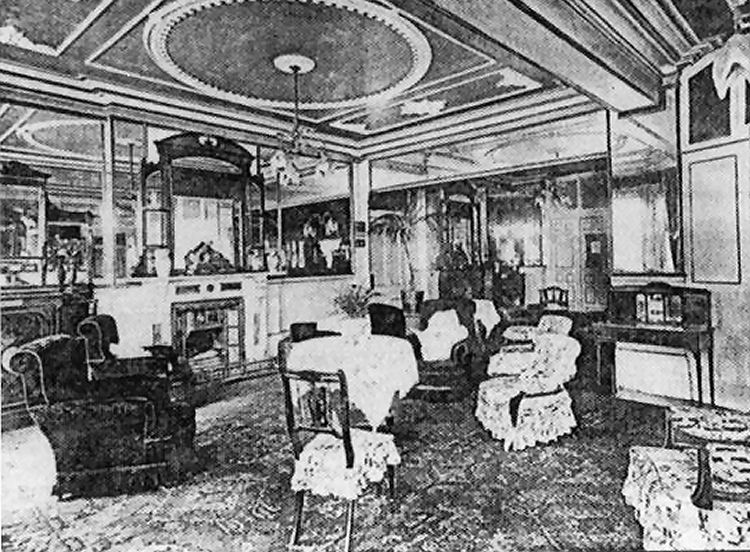
THE DRAWING ROOM
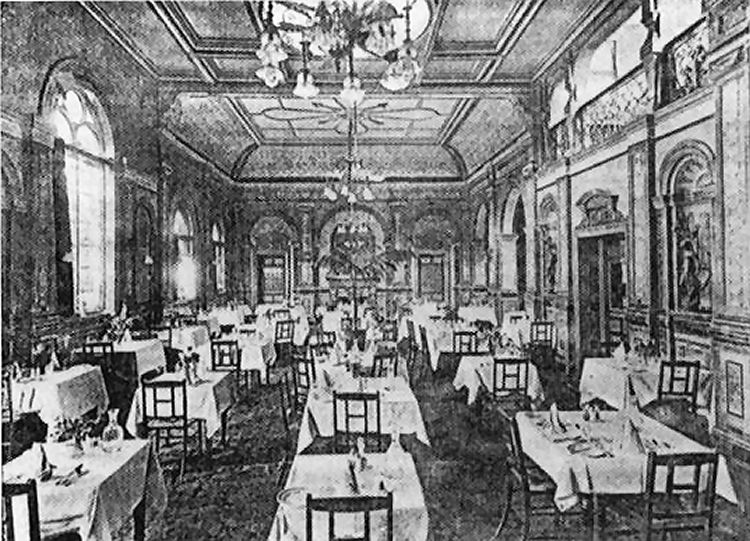
THE DINING ROOM
In 1936 the Wampach was owned by The Liverpool and Folkestone hotels
Ltd. The name had long reverted to The Wampach, and was in its hey-day
in 1937-38 when the Manager was Mr C. Ledermann.
Unfortunately, war broke out in 1939 and once again the hotel was taken
over by the army - this time by The Green Howards Regiment. The Wampach and
the smaller Private Hotels in Castle Hill Avenue were lined with barbed
wire and sentry boxes.
The Hotel escaped the bombs and shells, though it suffered a near miss
in October 1940 when there was a direct hit on two small hotels
opposite, resulting in two deaths. The site is now occupied by Hillstone
Court.
In 1942, Mr and Mrs Wampach, then living in Cheriton Road overlooking
Radnor Park, celebrated their 63rd Wedding Anniversary.
Mr and Mrs Wampach's eldest son, Alphonse Christian, died on the 9th,
November 1941, and as far as can be ascertained, Charles Constant Wampach died
on 29 September 1949 and probate was granted on 8th February 1950. Julie
had predeceased him, having died on 19 December 1944 (Probate: 10 Feb
1945). I can also say that Charles’ elder son Alphonse married Constance
Ellen DAYSON in 1902; they had five children but only one, Sylvia had
children. She had three, but one daughter, Sally, died aged 11. Of the
other two, Susan married and had two children, last heard of in Torquay,
Devon. Simon married in 1991 but I know of no issue.
THE CONTINENTAL WAMPACH HOTEL FOLKESTONE A SHORT
LIST OF RECOMMENDED
WINE
NEW YEAR'S EVE 1964-65
BORDEAUX RED |
No. |
Bot. |
½ Bot. |
1. MEDOC. Duchene Lemaire |
12/6 |
6/6 |
2. ST. JULIEN, Duchene Lemaire |
17/6 |
9/- |
BORDEAUX WHlTE |
6. GRAVES, Medium Dry |
14/6 |
7/6 |
7. BARSAC, Duchene Lemaire |
21/1- |
11/- |
9. SAUTERNES, Duchene Lemaire |
20/- |
10/ |
BURGUNDY RED |
14. BEAUJOLAIS, 1959, Marcel Baron |
15/- |
11/- |
15. COTE DE BEAUNE, 1962, Geisweiler |
20/- |
11/- |
17. NUITS ST, GEORGE, Picard, 1959 |
25/- |
14/ |
ROSE |
18. MATEUS ROSE |
21/- |
11/- |
RHONE WINES |
21. CHATEAUNEUF DU PAPE, 1961 |
22/- |
11/6 |
BURGUNDY WHlTE |
22. POUlLLY FUlSSE, 1959, Marcel Baron |
20/- |
10/6 |
23. CHABLIS, 1959, Tete de Cuvee |
25/- |
12/6 |
HOCKS-MOSELLE |
28. LIEBFRAUMILCH, Blue Nun, Sichel, 1962 |
30/- |
15/6 |
29. RUDESHEIMER, Riesling, 1959 Thoman |
30/- |
16/- |
SPARKLING WINES |
33. GOLDEN GUINEA, Sparkling Muscatel |
35/- |
18/- |
35. SPARKLING RED BURGUNDY |
35/- |
18/- |
CHAMPAGNE |
37. LOUIS LEBON, Special Selection |
37/6 |
19/6 |
38. MOET & CHANDON, N.V. |
42/- |
21/- |
41. HEIDSIECK DRY MONOPOLE, N.V. |
45/- |
23/6 |
42. MOET & CHANDON, 1955/59 |
45/- |
23/6 |
LIQUEURS, ETC. |
|
Glass |
BRANDY, Martell and Hennessey |
3/- |
BRANDY, Cordon Bleu |
3/6 |
Remy Martin |
3/6 |
PORTS - SHERRIES |
2/6 |
The Hotel required complete refurbishing after the occupation by the
troops for over four years, and it eventually re-opened in 1950.
The terms at that time were six to nine guineas per week, or 15/- per
night for bed and breakfast. There were also six flats in the hotel.
From 1952 one of these was occupied by Mr Harry Sargent, the hotel
manager - later to become the owner.
The Wampach became very popular during the late fifties and sixties. It
was renowned for its Wedding Receptions, catering, and the famous Toby
Jug Bar. The entrance to the latter was where the main entrance to Court
Place is today.
As holidays abroad became more and more popular, the holiday trade in
seaside resorts became less and less. When the Continental Wampach (as
it was then known) closed in the early seventies, Folkestone had already
lost other major hotels, including The Queen's, The Majestic and the
Esplanade.
In January 1973 plans were prepared for Rossglade Properties Ltd. to
build a one and a half million £ hotel on the site. It was proposed that
there would be underground parking on two levels, ninety single and
double bedrooms, and penthouse luxury suites. Also included would be
banqueting, conference and exhibition facilities.
Planning permission was applied for in May 1973, and granted by
Folkestone Town Council with certain provisos. 10 October Rossglade
agreed to reduce the depth of the building by eleven feet, to allow
council plans for a new court complex to go ahead.
The Town Council would then advise Kent County Council to agree the
plans.
There was disappointment in December when Rossglade's solicitors
informed
the owner of the Wampach, Mr Harry Sargent, that they were unable to
proceed as they could not raise the mortgage. The selling price was
believed to be between £150,000 and £200,000.
The Council were particularly disappointed as they had modified their
plans for the new Court building, County offices, and an Assembly Hall at
the Civic Centre to accommodate Rossglade's plans.
Until that time, Mr Sargent had been so confident of the sale going
through, that during the previous month all the hotel's furniture,
fixtures and fittings had been auctioned!
By the end of March 1974, another sale had been arranged, this time with
a local man, Mr Sidney de Haan, the owner of Saga Holidays. He had plans
to build a £40,000,000 International Conference Centre on East Cliff,
and to demolish the Wampach and build a much bigger hotel. The Herald
understood contracts had been exchanged.
Only one month later, at the end of April the hotel was wrecked by an
arsonist. Firemen said the four hour blaze appeared to have been started
in several areas at once. Brigades from Hythe, Canterbury, Ashford,
Dover, Deal and Folkestone were present.
During the night Mr Sidney de Haan stood in Castle Hill Avenue and
watched the blaze. He had completed the purchase with Harry Sargent only
the week before.
A spokesman said that Mr De Haan would not be making any claim against
the insurers.
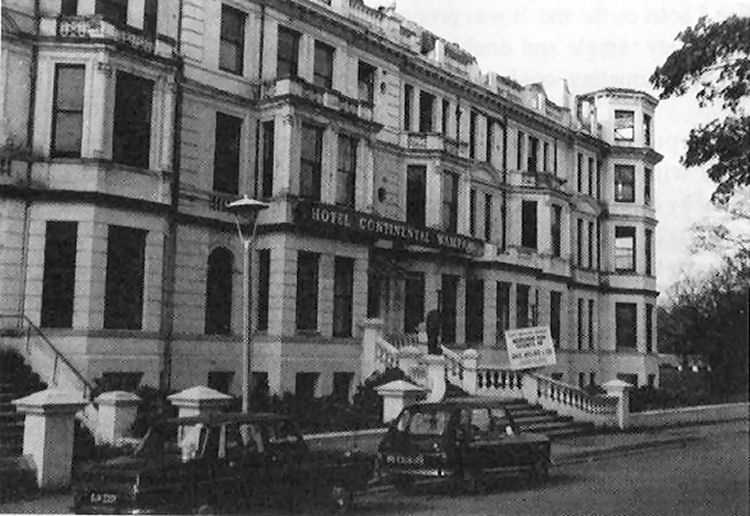
THE HOTEL CONTINENTAL WAMPACH AFTER THE FIRE
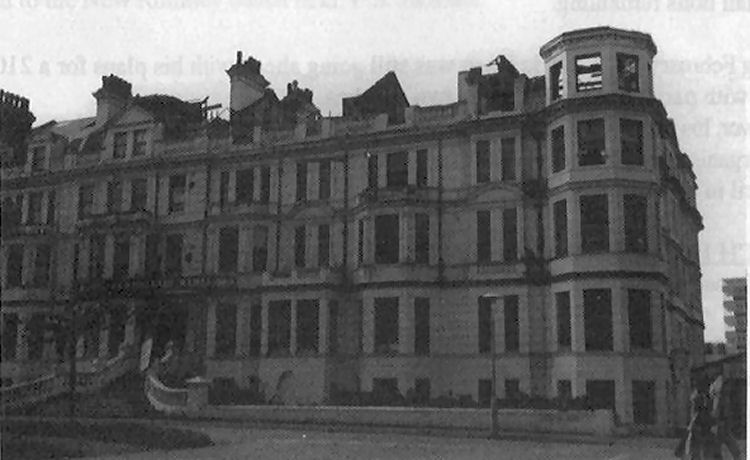
THE HOTEL CONTINENTAL WAMPACH AFTER THE FIRE
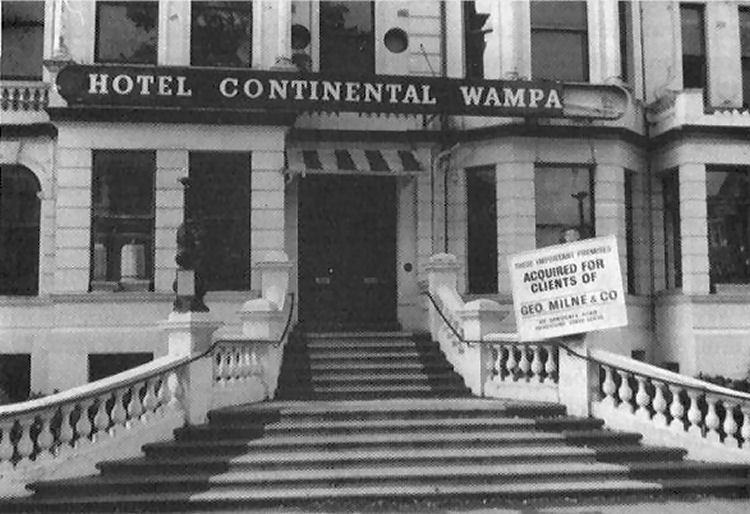
THE HOTEL CONTINENTAL WAMPACH AFTER THE FIRE
In March 1975 the Continental Wampach was reduced to a shell,
with just one of the two guardian lions remaining.
During February 1976 Mr de Haan was still going ahead with his plans for
a 210 bedroom hotel, with parking for 61 cars and two coaches.
However, his plans were being challenged in the High Court by the New
Folkestone Society. This organisation's aim was to quash the outline
planning permission given by the Shepway Council in 1974.
MARCH 1982. Since The New Folkestone Society began their legal battle,
Mr de Haan has been forced to mothball his plans for the past six years.
Mr William Miller, the owner of 27 Castle Hill Avenue, complained that
the crumbling hotel and the partly demolished house, number 29, were
attracting tramps, and was also a health hazard.
An argument flared between Sidney de Haan, Shepway Council, and the
owners of the leasehold - The Radnor Estate - as to who was responsible
for the demolition of the two buildings.
JULY 1982. The site by this time was described as being in a ruinous
condition.
The Wampach was not a listed building, but stood in a conservation area,
and listed building consent must be granted before complete demolition
can be ordered.
Involved in the dispute by this time were Mr Colin Miller, secretary of
the local resident's association, Shepway District Council, The New
Folkestone Society, M.P. Sir Albert Costain, the Minister of the
Environment, the local Ombudsman, individual district councillors, Mr
Sidney de Haan, and the Radnor Estate.
OCTOBER 1982. A notice to demolish or repair the remainder of 29 - 37
Castle Hill Avenue was ignored by both the owners of the buildings,
Radnor Estates, and Mc Sidney de Haao'sfinn, Saga, as lessees, therefore
Shepway had no choice but to agree to arrange the demolition the cost to
be recovered from one or the other.
It is said that the hotel had stood empty for so long, (over nine
years), the insides are crumbling, the roof is missing, and the floors
have collapsed.
NOVEMBER 1st. 1982 was the date arranged for the bulldozers to begin
demolition. Shepway Council had asked for tenders to pull the buildings
down, and the work was awarded to the New Romney based firm, F .S.
Jackson.
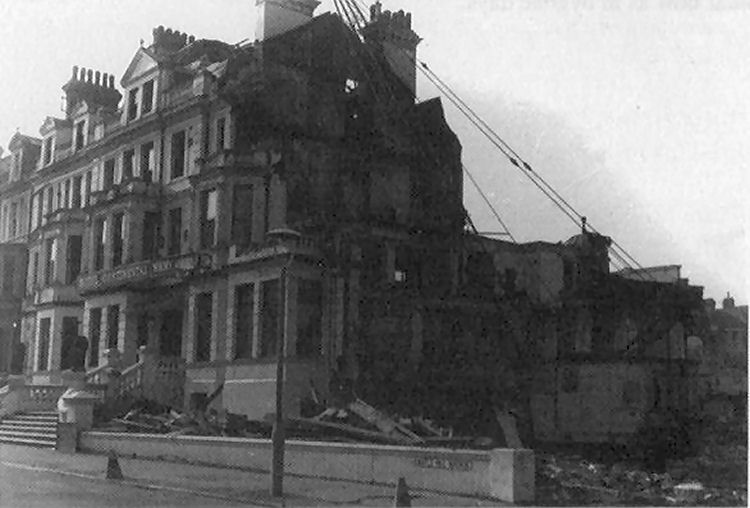
DEMOLITION WORK IN PROGRESS
The demolition and clearing of the site was completed by early 1983, and
in the following year Wimpey applied for planning permission to build a
block of 51 Retirement flats on the site.
In spite of bitter criticism from Councillor Chris Capon, who sided with
The New Folkestone Society that the flats should be occupied in part by
first time buyers, the Council agreed that they should be sheltered
flats, with a Warden's home and communal facilities.
Building work commenced in 1985 and the first of the residents moved in
during December 1986 - exactly one hundred years after CHARLES CONSTANT
WAMPACH opened Pension Wampach on this same site in 1886.
Court Place was officially opened by Folkestone M.P. Michael Howard in
March 1987, who commented on the striking similarity between the
contours of the modem building and The Hotel Continental Wampach.
Court Place Retirement Flats are proving to be on a very popular town
centre site, with easy access to the Leas, town centre, rail and coach
services.
When any flat comes up for sale it is usually taken very quickly, thus
making this Avenue as popular now as in bygone days.
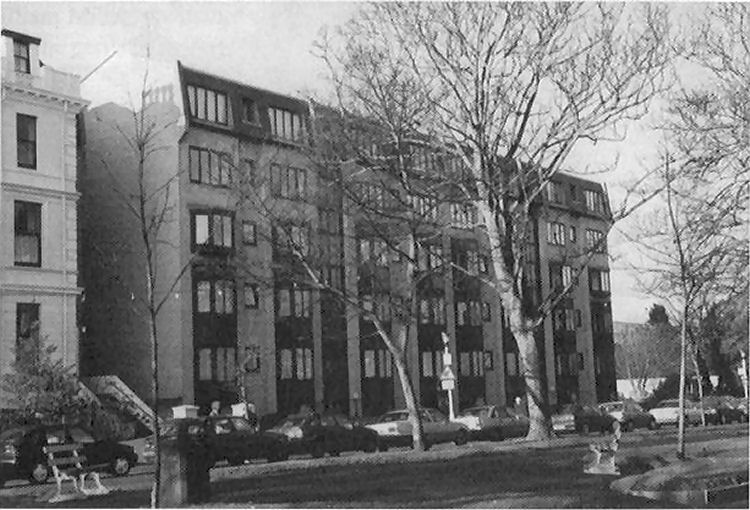
The completed Warden Housing project
COURT PLACE RETIREMENT FLATS
|
